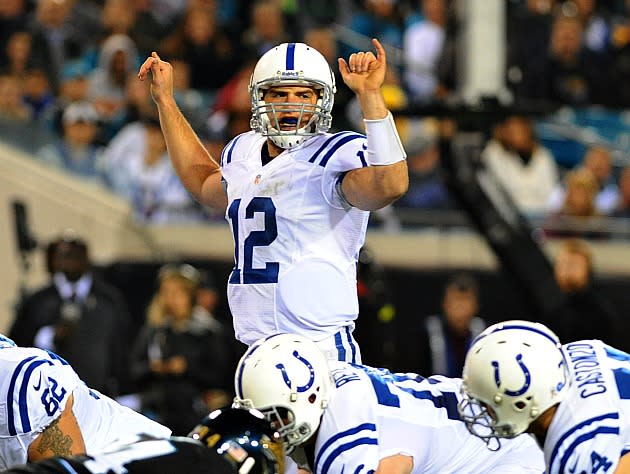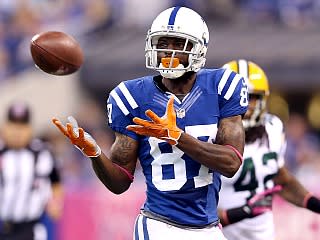Juggernaut Index, No. 16: The Indianapolis Colts

By any reasonable standard, Andrew Luck had a successful first season — in many ways, historically successful. Luck led the Colts to an 11-5 record and an unexpected playoff appearance, while establishing new NFL rookie records for passing yards in a season (4374) and game (433). He directed seven game-winning drives, which is insane.
True, his efficiency numbers weren't exceptional last year — 76.5 passer-rating, 54.1 completion percentage — but you really need to understand the system and team context. Last year, under then-coordinator Bruce Arians, Luck led all quarterbacks in deep pass attempts, and by a significant margin. According to Pro Football Focus, 101 of Luck's throws targeted a receiver at least 20 yards downfield. Those are generally low-percentage attempts with high potential yields.
We should also note that Luck was sacked 41 times, the fourth-highest total in the league, and he was hit while throwing another 14 times, which tied for the NFL lead. Indianapolis receivers dropped 50 of his pass attempts, the most in football (again, per PFF). The Colts running game wasn't particularly effective (3.8 YPC), and the team's defense ranked 26th overall, allowing 374.3 yards per game.
So let's not pretend Luck was dealt exactly the same hand as Russell Wilson or RG3, or whoever else. He was placed in a unique situation and performed unreasonably well. Andrew Luck, in a nutshell, is a damn good quarterback coming off a phenomenal year.
If you're at all worried about the departure of Arians ... well, don't sweat it. You'll like the new guy, too. Luck has been reunited with Pep Hamilton, his former OC at Stanford, so there's no need to worry about some steep, daunting learning curve. Hamilton's offense will feature West Coast principles, even if he's calling it a "No Coast" scheme.
Describing his system back in February, Hamilton offered this:
"If you look at what we were able to do successfully at Stanford, I think there was a good mix of [elements]. Early-down completion concepts, dropping back and throwing the football with three- and five-step drops, as well as the ability to knock the opponent off the ball and be physical in the run game, which in turn, opened up the passing game. ... So there's no 'can't do's' in our offense."
When things go according to script, you'll see high-percentage throws, run/pass balance and a ground game that effectively sets up play-action. (For the record, Luck was terrific in play-action as a rookie: 65-for-102, 6 TDs, 105.3 rating.) The deep strikes might come less frequently, yet have a greater chance of success. Indy certainly won't ignore the strengths of big-play receivers TY Hilton and Darrius Heyward-Bey, so it's not as if the vertical game will be completely absent.
Early reports from camp suggest the offense is humming...
Luck finishes 23-29 with 3 TDs. Had 14 straight completions at one point. #ColtsCamp
— George Bremer (@gmbremer) August 2, 2013
...so no one should expect Luck to take a backward step in 2013. His attempts may decrease while the completions hold steady — remember, this guy completed over 70 percent of his throws in back-to-back collegiate seasons. And of course the Colts could again find themselves in plenty of shootouts, boosting Luck's fantasy potential.
Luck is the eleventh quarterback off the board in an average Yahoo! draft (ADP 79.8), yet his ceiling is clearly much higher. I'll endorse any pre-draft plan that targets him in Rounds 7-9, allowing you to construct a deep, reliable group of backs and receivers with your early picks. It's not difficult for me to imagine Luck making a value leap in his second season, even if he doesn't rush for another five scores. Expect more touchdown passes, a much higher completion rate, fewer sacks, and far fewer negative plays — no way he's throwing another 18 picks. I'm on board.
_
Reggie Wayne had a far more productive season in 2012 than anyone projected, hauling in 106 balls for 1355 yards on 195 targets (second-most in the NFL). Wayne topped 70 receiving yards in each of his first 11 games, so week-to-week consistency wasn't a worry. He'll turn 35 in November, but he'll remain the primary target in a productive offense, tied to an excellent QB. He also had a stellar season at age-34, so I'm not about to predict a collapse.

Early fantasy drafters don't seem terribly interested in Wayne's brand of dull, steady productivity — they're selecting 16 other receivers before him. But I've ranked Wayne ahead of his current ADP, so I've landed him in virtually all mocks and drafts. He's generally available in the Bowe-Welker-Wallace range; you won't take a loss at that price.
Hilton had an impressive first season for Indy, catching 50 passes for 861 yards and seven TDs, though he left a few fantasy points on the field (10 drops). He might be utilized differently this year, but he'll remain a dangerous weapon in this offense. This from the Terre Haute Trib-Star:
So far, new offensive coordinator Pep Hamilton has used Hilton all over the field. He’s lined up on the outside to the left and the right, and he’ll also see time in the slot.
[...]
“That guy’s a freak,” head coach Chuck Pagano said. “I’d hate to be the guy on the opposite side of the ball."
Within the fantasy community, far too much concern has been expressed over Heyward-Bey's arrival, and the potential impact on Hilton. Let's recall that Donnie Avery, now with KC, played many more snaps than Hilton last season (1044 to 682) and saw many more targets (124 to 90). If Hilton's workload remains the same and his hands function a bit better, he'll deliver a solid stat line. The Indy passing game should be good enough to support more than one ownable wideout, so TY and DHB are both reasonable late-round targets, available beyond pick 100. With second-year receiver LaVon Brazill suspended four games, Nathan Palmer and Griff Whalen may see a few early season snaps. But now we're well beyond the names you need to know.
Coby Fleener and Dwayne Allen form one of the NFL's better tight end tandems, and both players belong on the fantasy radar. Neither carries a high price at the draft table. Fleener had a mostly quiet rookie season, but he's a gifted receiver who thrived in the Luck-Hamilton offense at Stanford, and he's been a buzzy player in camp. Allen is more of a do-it-all tight end, and he was more productive than Fleener a year ago. You won't be drafting either of these guys in standard 10 and 12-team leagues, but they belong on your watch list. In deeper leagues, I'd lean toward Fleener over Allen.
Indianapolis upgraded its O-line via free agency (Gosder Cherilus, Donald Thomas), which should help preserve the team's franchise QB and hopefully aid the run game. Ahmad Bradshaw signed with the team late in the offseason, but he's basically a theoretical addition at this point — he opened camp on the PUP list, recovering from his millionth foot surgery. The Colts gave him a one-year prove-it deal, so this is basically a no-risk proposition for the team. When healthy, Bradshaw is a solid multi-purpose back, a dynamic ball-carrier and capable receiver, excellent in pass protection. He rushed for 1015 yards in New York last season, gaining 4.6 per carry. You can't reasonably expect a player with Bradshaw's medical history to take every last carry, but 220-240 touches seems doable. Vick Ballard proved reliable if not spectacular as a rookie, averaging 3.9 YPC and gaining 966 scrimmage yards. He'll see plenty of first-team reps in camp with Bradshaw sidelined. Think of him as a high-end handcuff. And try not to think of Donald Brown ever again.
The Colts defense shouldn't really be in your fantasy plans, unless perhaps you're streaming this unit in a deep league when they face Oakland (Week 1) or Jacksonville (Week 4). Indy has made a few notable additions on defense — SS LaRon Landry, first-round LB Bjoern Werner — but I can't (and won't) build a case for this D/ST as a legit fantasy commodity.
As far as I'm concerned, this defense's job is to allow points, so Luck never, ever stops throwing.
2012 team stats: 22.3 points per game (18), 273.4 passing yards per game (7), 104.4 rushing yards per game (22)
Previous Juggernauts: 32. NY Jets, 31. Oakland, 30. Jacksonville, 29. Buffalo, 28. Cleveland, 27. Tennessee, 26. San Diego, 25. Miami, 24. St. Louis, 23. Pittsburgh, 22. Arizona, 21. Minnesota, 20. Kansas City, 19. Chicago, 18. Baltimore, 17. Philadelphia

 Yahoo Sports
Yahoo Sports 

